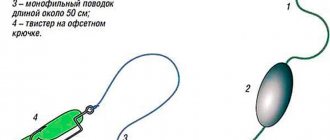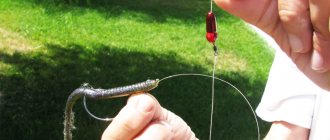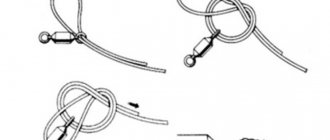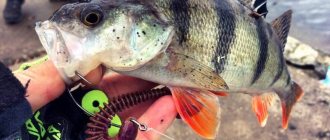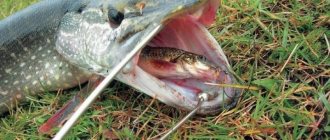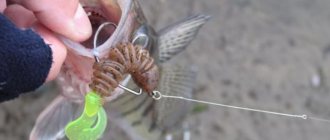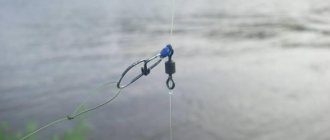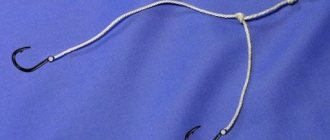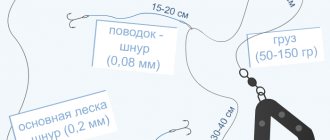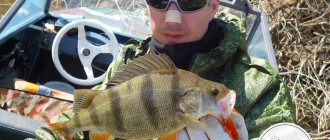Review of spinning rods
February 03
Review of retractable leashes for spinning rods
Every spinning angler is familiar with the combination “retractable leash”. For some, this is the first gear with which they began their journey in fishing; for others, it is one of the frequently used methods of fishing. Line fishing is one of the possible ways to catch a precious trophy when other types of fishing are unavailable or do not work. But in order to catch a predator and become the envy of other fishermen, you need competent knowledge of the methods of rigging a retractable leash and the practical application of fishing techniques.
The concept of a diverter leash
A retractable leash (or Moscow rig) is one of the types of rigs for spinning. Has a spaced type. Designed for soft type jigging baits. The design of the diverter leash consists of two parallel lines of approximately 20 centimeters and 100 centimeters, respectively. A load is attached to the smaller segment, and a hook and bait are attached to the larger segment. The advantage of fishing this way is the soft sliding of the hook with bait in the water. The weight falls to the bottom, and the bait moves slowly, attracting the attention of the predator. Thanks to such an interesting movement, even an insecure predator will show interest in the bait. Experienced fishermen note that sometimes only this method of fishing can awaken the fish during a period of complete absence of bite.
Popular fishing techniques
When using the technique of fishing with a retractable leash, you can use different types of wiring. There is no main one, because any technique can show good results if applied in the right situation.
Step wiring can be used. Only it should be smooth, not sharp. With even retrieving, the bait simply drags along the bottom of the reservoir. Quite often, a slow retrieve, when the angler pauses and pumps the rod tip, produces good results.
Pauses are very important for this type of fishing. When the movement stops, the bait begins to either float or sink. Even the most passive perch will pay attention to this and get caught.
The bite when fishing with a lead rig can occur in different ways. It may feel like a sharp jerk or a gentle tug. Sometimes it feels like the fish is nibbling or chewing on the bait. You can hook only when the perch swallows the bait.
With a sudden movement, the thin lips of the perch will tear. When fishing, you should also not forget about this, otherwise the prey may escape. Let the perch get a little tired, and only then pull it out of the water.
In places where there is a high probability of grass being collected on the hook, use an offset hook with a corresponding twister. In general, you can use a regular hook, commensurate with the size of the twister.
Accessory for diverting leash
You need to have a certain set of gear and remember some rules when planning fishing in this way.
1. It is necessary to have a spinning rod with good sensitivity and fast action so that the angler can perfectly grasp how the bait behaves. 2. It is better to use braided line as the main line. This line has good sensitivity and will be able to catch even the weakest bite. Some anglers replace it with a braided line. 3. The retractable leash carries less load, so you can use monofilament fishing line for it. Some people use a metal leash instead of a fishing line. 4. When fishing with a retractable leash, it is better to use a rod of about 250 cm (in the case of fishing from a boat). If you fish from the shore, it is preferable to use a spinning rod of about 270 cm. 5. The leash on which the load is attached should be 20-30 centimeters in length. The second leash with a hook and bait can be from 50 cm to 150 centimeters. 6. The type of hook depends on the bottom of the reservoir where the fish will be caught. If the bottom is clean, you can use a regular hook; if it is grassy, use an offset type hook. The type of hook is selected taking into account the bait and type of fish.
The weight of the cargo also depends on the reservoir, its depth and current. As a rule, the weight of the cargo usually falls within the range from 5 grams to 25 grams. The shape of the weight is determined by the bottom topography and the current in the reservoir.
It is better to fish on a retractable leash using silicone baits. They come in different colors, shapes and sizes. Some of them are treated with special salt and substances that attract fish. For example, perch will bite on salty bait, while pike do not attach importance to such features.
In order to use the technique of fishing with a retractable leash, you need to install this device.
Fishing rod with retractable leash
When choosing a fishing rod with a retractable leader, you should first of all pay attention to such blank parameters as:
- build;
- length;
- test.
For cast-off fishing, a fast or ultra-fast action rod is suitable . Stiffer, ultra-fast blanks are primarily suitable for hunting pike and zander, which are better attracted by sharp jerky movements. If you plan to catch perch primarily, the spinning rod can be softer and have a fast action.
As for the length , when fishing for pike perch and pike, it is better if it is short: with a short spinning rod it is easier to carry out a sharp retrieve of the bait on a retractable leash. You can take a longer fishing rod for perch hunting.
The rod test is selected based on the weight of the baits to be used. As a rule, when fishing with a retractable leash, fairly heavy loads are used (2-3 times the weight of the jig heads that would be needed for classic jig fishing under the same conditions).
Installation of a diverter leash for a spinning rod
Installing a diverter leash is a simple science, but, as in any matter, practice is necessary. Having tried different methods, the fisherman sooner or later settles on one of them.
Experienced fishermen distinguish several installation methods:
1. Blind installation method (loop to loop). A simple method, suitable even for a beginner spinner. A weight is attached to a long fishing line. After 20-30 centimeters you need to tie a loop, onto which a hook with bait is then attached. 2. Complicated type of installation. When using this method, instead of a loop, a swivel or carabiner (double or triple) is attached. Another leash is tied to it. With a triple swivel, it is possible to separate into three different lines - a weight, a hook and a bait. This method has its advantages. If one part gets stuck, it can be removed. The rest of the equipment will remain unharmed. Swivels help the tackle not to twist or get tangled. 3. Sliding type of installation. The essence of this method is that a bait is attached to a long (main line), while a weight on a separate leash slides along it. The length of the leash with a weight is 20 cm -30 cm. It is attached to a carabiner. The main line is passed through the second eye of the swivel. At the end of the fishing line there is another carabiner, the same size as the first. Its function is to stop the fishing line with a weight and a leash attachment with a hook. When using this type of installation, you can easily swap the line with the weight and the line with the hook. Then the segment with the bait will be sliding. Such actions are undesirable, because when the spinning rod is cast, the weight will move further than the bait. To limit the area of movement of the sliding leash, you can install an additional swivel on the main line. It is better to attach it after 25-30 centimeters.
These methods are the most common among fishermen. But there are other types of installation. They can also be mastered in practice.
Fishing with a retractable leash (wiring)
The diverter leash for pike perch, pike and perch works according to the same scheme and there is no difference in their structure.
When fishing from the shore, most often the equipment is thrown to the maximum distance. In this case, it is advisable to take into account the nature of the bottom and avoid fishing in highly snug places, since the entire fishing process involves tapping the bottom with a sinker, followed by a meter-long leash with bait.
After the bait falls into the water, wait until it reaches the bottom; with the line taut at the tip of the rod, you will feel a weakening - it’s time to make a small reel. Rewinding can occur either slowly or quickly, but with stops. Most often this is 2-4 turns of the coil and stopping for a few seconds.
During stops, your line should be taut and if a bite occurs, hook it immediately. The pike perch has a very strong jaw, which cannot be caught with a light hook.
During retrieving between pauses, you can play with the tip of the rod, thereby giving even greater vibration to your bait.
See how a professional fisherman wires a lead rig with a twister.
A retractable leash is more promising than standard jig tackle in that the likelihood of the bait getting caught is much lower, because it is more often in the water and not on the bottom. The action of the bait is also not constrained by a heavy load.
You can use several baits and several leashes in a rig. The next leashes should be shorter than 1 meter and located at a relative distance from the first one so as not to catch each other.
The success of fishing greatly depends on correct wiring. In bad weather, sluggish fish prefer slow-moving prey, take this into account.
Comments
Is it possible to catch pike this way? and what test is needed for a spinning rod?? and what is better to use fishing line or thread?
The spinning rod test should be 40-120 grams and it is better to use braid.
Will regular silicone with a jig work?
For fishing with a retractable leash, it is better to use braided line, since fishing takes place at depth and you need to tap the bottom with a weight. No stretching is very important here.
I don’t know what you mean by ordinary silicone. Twisters and vibrating tails without a jig head are suitable. It is still better to use a weight in the form of a pear or a tube (without a hook, of course) - so that there are no snags.
thanks a lot !! and one more question!! but what if the pike walks on the surface??how to do the wiring??
and another question: if the reservoir is no more than 25 cm, is it possible to fish there?
If the depth is shallow, then a diverting leash is not needed here - use wobblers, ranoutrom.com/sposoby-lovli/shhuka/rybalka-na-voblery.html here is about choosing wobblers for pike and correct wiring.
If you are sure that there is a pike in the reservoir, then you can catch it.
The spinning test primarily depends on the size of the bait. In principle, from 15 to 40 is quite good for a lead and jig fishing. Naturally, you can catch pike. Take only larger baits and experiment with colors. In one weather and place it will be taken with dark or natural colors, on another day and in another place - with fluorescent baits.
Do you need a carbine for a silicone fish? (regular) or should it not spin?
Alexander, do you mean vibrotail? It is better to use a swivel, especially when fishing with a twister. Without a swivel, the equipment will still twist, regardless of how the vibrating tail behaves in the water.
It is better to install a three-way swivel in the place where the diverter leash is attached - there will be less confusion.
And if you put small carbines everywhere, then the tackle turns into an easily dismountable and easily transportable option. Plus, if you are fishing for perch, try a small unshipped perch spinner instead of silicone...also a cool option.
I read a lot of good advice. Thanks for the detailed descriptions. Happy fishing everyone. Ladoga)))
And what kind of lures are needed for catching pike, I used all the wobblers but none of them helped. Young man, help me and tell me how and what bait I should use to catch this pike. Help.
Great info, thanks a lot
I fish with edible rubber, it’s a little expensive, but it all pays off with interest...
Oleg, why is this here?
I do the installation as follows: the main one, put the smallest swivel on it in one ear, then the same swivel in both ears of the main one, two turns each so that it slides along the main one with a weight at the end
When fishing, the swivel moves towards the leash, respectively, thereby also reducing the risk of getting caught in the load and losing the trophy. I only use monofilament. The river has 70-90 meters of driftwood. I carry a kilo of weights and bait with me. But the result is not bad at times.
It can be done easier by using float stop beads, two or three pieces in a row, depending on the expected size of the fish when biting. Then, when hooking, the leash moves towards the sinker and the fishing process improves significantly.
What is the best way to catch herring?
Retractable leash catcher when the sinker walks along the main line
Very informative, thanks to the author! I tried a retractable leash in the summer, it is much more effective than a jig in terms of the number of fish. Have you tried fishing with a retractable leash in late autumn, or even in autumn at all, will it bite?
I fished with a leash from May to November, catchy and simple tackle, and edible rubber on the underwater increases the number of bites.
I catch Bass using all sorts of perch methods...thanks for the advice...Perch or Bass stopped biting in November, maybe a retractable leash will help...we'll try! !!
I didn’t catch any bass, but the perch pecked until the ice on the outlet.
I want to see how they fish with a wobbler on the lake and a sinker
At shallow depths, up to 3-4m, in a gentle current, it is most convenient to catch perch using a regular light jig or microjig. At great depths, at steep changes in depth, on the slopes of steep edges, in currents - this is no longer so convenient, and sometimes impossible. I wrote about the possibilities of catching perch in such situations using a drop-shot rig in one of my recent articles. So, I won’t repeat myself. In approximately the same conditions, a retractable leash helps to catch perch perfectly.
Date: January 25, 2021 | 562
When fishing, different conditions happen; we find ourselves in different bodies of water, in different places. Perches can be found in shallow areas, at medium depths, and in fairly deep places. Especially at relative depths, large specimens, coveted by all spinning anglers, humpback perch, are kept.
At shallow depths, up to 3-4m, in a gentle current, it is most convenient to catch perch using a regular light jig or microjig. At great depths, at steep changes in depth, on the slopes of steep edges, in currents - this is no longer so convenient, and sometimes impossible. I wrote about the possibilities of catching perch in such situations using a drop-shot rig in one of my recent articles. So, I won’t repeat myself. In approximately the same conditions, a retractable leash helps to catch perch perfectly.
So, those spinners who are fixated on the classic jig lose a lot by not using spaced rigs in their practice, on occasion.
A rig with a retractable leash for perch is not fundamentally different from its basic version. A leash is placed on the main line in one way or another. It can be rigidly fixed, tied, or slide between the stoppers. I think you know how to tie a lead leash to the main line.
The leash itself is usually made quite long, about 1.5 m. Since we went to complicate the installation, then use the possibilities to the fullest. And move the sinker away from the eyes of the fish, and on a long leash the bait plays more naturally. In this regard, the natural play of silicone, especially in the current, the retractable leash greatly outperforms the same drop-shot.
It is recommended to tie the hook not just with a tight knot, but with the formation of a loop along which the hook ring will move and slide freely. This gives more freedom to the action of the bait.
You can use a regular single or offset hook. On a single hook, the bait can be attached with the front part, like a worm. Or maybe it just gets caught on the very front. The second method allows you to show a more lively and active game of the bait. This way you can earn more bites, but there will also be many more bait failures.
As bait for perch on a retractable leash, they usually use not very large edible fish, ranging from 1.5”-2” to 3”-3.5”, rarely more.
Catching perch on a retractable leash goes well with the use of floating silicone baits. When silicone, being slightly loaded by the weight of the hook and constrained by a leash, hangs in the thickness, slowly floats up, or slowly sinks, this very well provokes the perch to bite.
In terms of the type and shape of silicone baits, there are practically no restrictions. With a retractable leash, active baits (vibrotails and twisters) and a full range of passive baits (slugs, silicone worms, crayfish, various creatures) are well used. If the goal is to catch a particularly large perch on a retractable leash, I would give preference to slugs or hybrids (worm with a twister tail) of at least 3” in size.
Of course, it is not at all necessary to use a retractable leash everywhere and always. Personally, I resort to it relatively rarely:
- When the fishing spot is far away. You need to use a heavy load and want to use a small bait.
— When you need to fish a steep river edge on a river with a noticeable current.
- When the fish is at a decent depth and there is at least a slight current.
— When the fish is cautious and does not want to be caught with the classics.
In still water I prefer a Carolina rig or a drop shot. And I prefer the outlet, mainly in the current.
Well, I came across a photograph on one of the forums that clearly illustrates the effectiveness of equipping a diverting leash for large perch.
Fishing in deep water, at significant depths, goes very well with this equipment and often allows you to achieve much better results than with a conventional microjig.
Offset hooks are used, Owner is best suited - they are distinguished by high-quality sharpening and penetrate the fish’s jaw well, minimizing the risk of derailment.
